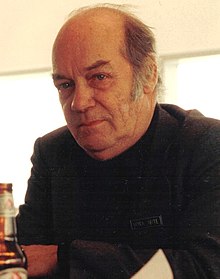Alfred Earl "Al" Hansen (5 October 1927 – 20 June 1995)[1] was an American artist. He was a member of Fluxus, a movement that originated on an artists' collective around George Maciunas.
Al Hansen | |
|---|---|
 Al Hansen, 1994 in San Francisco | |
| Born | 5 October 1927 New York City, U.S. |
| Died | 20 June 1995 (aged 67) |
| Nationality | American |
He was the father of Andy Warhol protégé Bibbe Hansen[2] and the grandfather and artistic mentor of rock musician Beck and artist Channing Hansen. Bibbe and Channing continue his legacy by performing some of his most iconic works.[3]
Biography
editHansen was born in 1927 in New York City, to a family of Norwegian heritage. He was a friend to several notable artists, including Yoko Ono[4] and John Cage. Hansen served in Germany during World War II. During his service, Hansen once pushed a piano off the roof of a five-story building, which became the foundation of one of his most recognized performance pieces, the Yoko Ono Piano Drop. Many artists have also destroyed or altered pianos including John Cage, Joseph Beuys, Nam June Paik[5] and Raphael Montañez Ortiz.
Hansen studied with composer John Cage at the now famous 1958 Composition Class at the New School for Social Research in New York City along with fellow students, Dick Higgins, George Brecht, and Allan Kaprow amongst others.[6] Hansen was perhaps best known for his performance pieces, his participation in Happenings, and for his collages in which he often used cigarette butts and candy bar wrappers as the raw materials, among them numerous variations of a sculpture referring to the Venus of Willendorf.[7]
He wrote an important book about performance art, A Primer of Happenings and Time Space Art published by Something Else Press in 1965.[8]
In 1966 he attended the Destruction in Art Symposium in London organized by Gustav Metzger,[9] where he met and befriended many of the Viennese Action Artists. In October 1966 Otto Muhl organized an event called "Action Concert for Al Hansen" in Vienna.[10]
Hansen was a frequent visitor to The Factory, Andy Warhol's studio in New York.[11] In 1969, Hansen founded the underground magazine Kiss, which featured a gossip column by Warhol and contributions by his Factory superstars.[12]
He was an art professor at Rutgers College in Newark, New Jersey, into the 1970s.
In 1977 Hansen managed Los Angeles punk bands the Controllers and the Screamers in Hollywood. In the 1980s Hansen moved to Cologne, Germany, where he and colleague Lisa Cieslik [13] established an art school, the Ultimate Akademie. Inspired among others by the Final Academy of Genesis P-Orridge it became a meeting point for local and international performers of the time-based arts.
He died in Cologne, Germany, in 1995, with a number of friends celebrating a Fluxus funeral according to his plan.[citation needed]
Notable collections
edit- Archivio Conz - Francesco Conz's Collection
- Yes She He, c. 1962, Hirshhorn Museum and Sculpture Garden, Washington, D.C.[14]
- Coco Was a Poco Loco about Cacao and Men, 1968, MoMA, New York, NY[15]
- John Cage Word Opera, 1972–1076, Walker Art Center Minneapolis, MN[16]
- Amazone Venus 3/9 1994, Kölnisches Stadtmuseum.[17]
- Yayoi Kusama's Yokohama Hammock 1963, Museum Moderner Kunst Stiftung Ludwig Wien Vienna.[18]
References
edit- René Block, Gabriele Knapstein: 'A long story with many knots. Fluxus in Germany 1962–1994.' (Eine lange Geschichte mit vielen Knoten. Fluxus in deutschland.) Institute for foreign relations (Institut für Auslandsbeziehungen), Stuttgart, Germany, 1995
- ^ Roberta Smith (27 June 1995). "Al Hansen, 67, Artist Who Created Happenings". The New York Times. p. D21.
- ^ Alexander Cavaluzzo, "Our real art is our interaction with the world", 17 Nov 2011
- ^ David Velasco, "Total Bequest Live", Artforum, April 28, 2006
- ^ Ethan Smith "Beck and Yoko Ono sound off on found art, family ties, and flying pianos" Archived 12 November 2013 at the Wayback Machine, New York Magazine Sept 1, 1998
- ^ "Museum Zero"
- ^ Joseph Jacobs, "La Clase de Cage" Archived 10 June 2015 at the Wayback Machine
- ^ Wayne Baerwaldt [1] "Beck and Al Hansen Playing With Matches" Smart Art Press 1998
- ^ Steve Clay, " Something Else Press: Exploring the Ways and Means of Communication", Fluxus Heidelberg Center BLOG 25 June 2009
- ^ "Gustav Metzger: Auto-Destructive Art"
- ^ mumok, "Museum Moderner Kunst Stiftung Ludwig Wien"
- ^ Jesse Kornbluth, "New York Magazine" 9 March 1987
- ^ Kimpel, Dan (2006). How They Made It: True Stories of How Music's Biggest Stars Went from Start to Stardom!. Hal Leonard Corporation. p. 7. ISBN 978-0-634-07642-8.
- ^ Gomm, Barbara (October 1987). Kölner Express.
- ^ "Yes She He, (c. 1962)". Collection. Hirshhorn Museum and Sculpture Garden. Retrieved 16 January 2013.
- ^ "The Collection MoMA New York, NY"
- ^ "Walker Art Center, Minneapolis, MN"
- ^ "Kölnisches Stadtmuseum"
- ^ mumok Museum Moderner Kunst"
